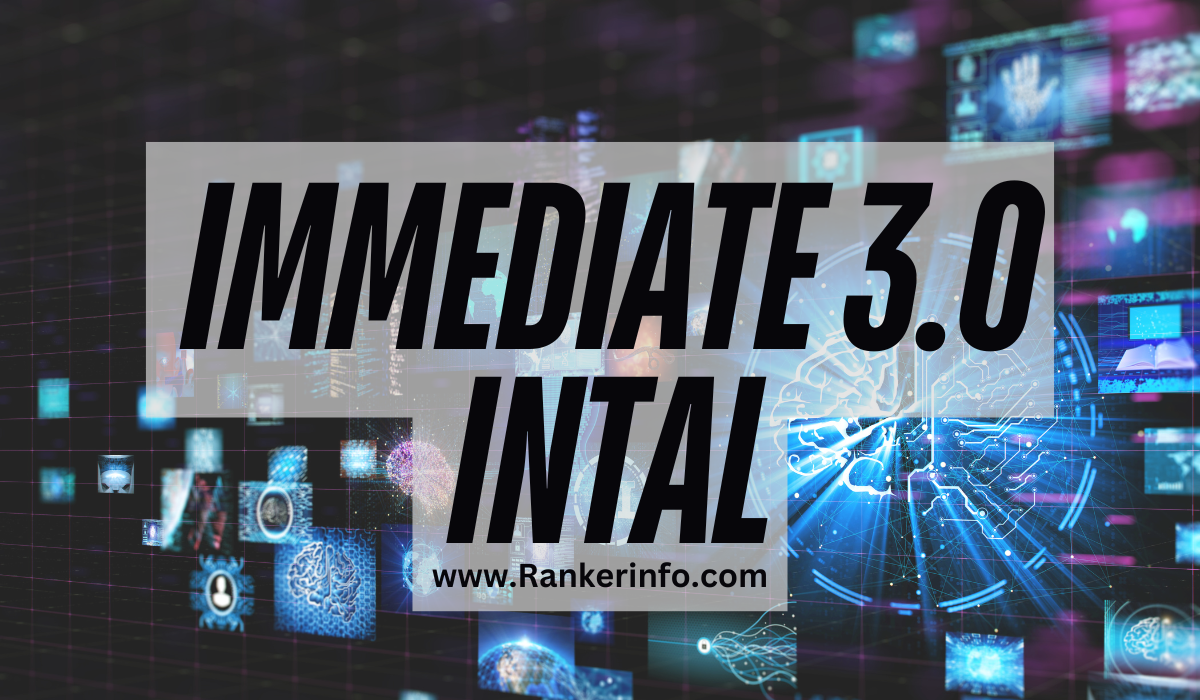Immediate 3.0 Intal represents a significant evolution in technology, combining advancements in data analytics, artificial intelligence, and process optimization. This transformative framework enables organizations to streamline operations, enhance decision-making, and ultimately drive substantial business growth. As we explore Immediate 3.0 Intal in this comprehensive article, we will delve into its definition, applications across various sectors, challenges faced during implementation, and future trends. Moreover, we will present relevant statistics and case studies to illustrate the powerful impact of Immediate 3.0 Intal on organizations and industries worldwide.
Key Takeaways from the Article:
- Definition and Overview: Immediate 3.0 Intal signifies the latest advancements in technology, particularly in data analytics and artificial intelligence.
- Statistical Impact: Studies indicate that organizations utilizing Immediate 3.0 Intal have improved efficiency by up to 40%.
- Applications: Immediate 3.0 Intal can be applied across various sectors, including healthcare, finance, and education.
- Challenges and Solutions: Despite its benefits, implementation challenges exist, such as resistance to change and training requirements.
- Future Trends: The future of Immediate 3.0 Intal suggests increased integration with IoT and blockchain technologies.
- Case Studies: Several organizations have successfully adopted Immediate 3.0 Intal, resulting in significant operational improvements.
What is Immediate 3.0 Intal?
Immediate 3.0 Intal is a term that encapsulates the integration of cutting-edge technology into immediate decision-making processes, leveraging real-time data analytics, machine learning, and artificial intelligence. The goal is to enhance operational efficiency, improve strategic planning, and drive superior business outcomes.
According to a report by McKinsey, companies utilizing advanced analytics and machine learning can improve their efficiency by 40%, demonstrating the significant impact of Immediate 3.0 Intal on productivity.
Key Features of Immediate 3.0 Intal
- Real-Time Data Processing: Immediate 3.0 Intal emphasizes the importance of analyzing data as it is generated, allowing for quicker decision-making.
- Enhanced User Experience: Through machine learning algorithms, the technology tailors user experiences, leading to increased engagement and satisfaction.
- Predictive Analytics: Utilizing historical data and trends, Immediate 3.0 Intal can predict future outcomes, helping businesses strategize effectively.
- Automation of Routine Tasks: By automating repetitive tasks, organizations can focus on more strategic initiatives, leading to greater innovation.
How Can Immediate 3.0 Intal Benefit Different Industries?
Healthcare
In healthcare, Immediate 3.0 Intal facilitates improved patient outcomes by leveraging data for personalized treatment plans. A study by the Journal of Medical Internet Research found that the implementation of AI in healthcare led to a 30% reduction in patient readmission rates.
Finance
In the finance sector, Immediate 3.0 Intal enhances risk management and fraud detection. According to a PwC report, 86% of financial institutions have adopted AI for various purposes, significantly improving their operational efficiencies.
Education
In education, Immediate 3.0 Intal supports personalized learning experiences. A survey conducted by EdTech Magazine showed that 70% of educators believe that data-driven technologies enhance student engagement.
Impact of Immediate 3.0 Intal Across Industries
| Industry | Impact | Percentage Improvement |
|---|---|---|
| Healthcare | Reduced patient readmission rates | 30% |
| Finance | Improved operational efficiency | 86% |
| Education | Enhanced student engagement | 70% |
Challenges in Implementing Immediate 3.0 Intal
Despite its numerous advantages, organizations may encounter various challenges when implementing Immediate 3.0 Intal:
Resistance to Change
Employees may resist transitioning to new technologies due to fear of job displacement or unfamiliarity with the new systems. Change management strategies, including training and clear communication, are crucial to overcoming this barrier.
Training Requirements
The implementation of Immediate 3.0 Intal often necessitates comprehensive training programs to ensure that staff can effectively utilize the new tools. Companies should allocate resources for ongoing education and support.
Initial Costs
The initial investment required for technology integration can be significant. However, the long-term benefits, such as increased productivity and cost savings, can offset these costs.
Challenges of Implementing Immediate 3.0 Intal
| Challenge | Description | Solution |
|---|---|---|
| Resistance to Change | Fear of job loss and unfamiliarity with technology | Implement change management strategies |
| Training Requirements | Need for comprehensive staff training | Allocate resources for ongoing education |
| Initial Costs | Significant investment for technology integration | Focus on long-term cost savings |
Future Trends in Immediate 3.0 Intal
The landscape of Immediate 3.0 Intal is continually evolving, with several key trends anticipated in the coming years:
Increased Integration with IoT
The Internet of Things (IoT) is expected to play a crucial role in the evolution of Immediate 3.0 Intal. The interconnectedness of devices will enable even more comprehensive data analysis and real-time decision-making.
Advancements in Blockchain Technology
Blockchain technology offers unparalleled security and transparency, making it a valuable asset for organizations adopting Immediate 3.0 Intal. This integration will enhance data integrity and trust in the decision-making process.
Rise of Predictive Analytics
As data continues to grow exponentially, the reliance on predictive analytics will increase. Organizations will leverage these insights to make informed decisions, minimizing risks and maximizing opportunities.
Future Trends in Immediate 3.0 Intal
The landscape of Immediate 3.0 Intal is continually evolving, with several key trends anticipated in the coming years:
Increased Integration with IoT
The Internet of Things (IoT) is expected to play a crucial role in the evolution of Immediate 3.0 Intal. The interconnectedness of devices will enable even more comprehensive data analysis and real-time decision-making.
Advancements in Blockchain Technology
Blockchain technology offers unparalleled security and transparency, making it a valuable asset for organizations adopting Immediate 3.0 Intal. This integration will enhance data integrity and trust in the decision-making process.
Rise of Predictive Analytics
As data continues to grow exponentially, the reliance on predictive analytics will increase. Organizations will leverage these insights to make informed decisions, minimizing risks and maximizing opportunities.
Future Trends of Immediate 3.0 Intal
| Trend | Description | Potential Impact |
|---|---|---|
| Integration with IoT | Enhanced data connectivity across devices | Improved real-time analytics |
| Blockchain Technology | Increased security and transparency | Greater trust in data integrity |
| Predictive Analytics | Advanced forecasting capabilities | Better risk management |
Real-World Applications of Immediate 3.0 Intal
Retail
In the retail sector, Immediate 3.0 Intal is utilized for inventory management and personalized marketing. Companies like Amazon use predictive analytics to forecast demand and optimize inventory, leading to improved customer satisfaction and reduced costs.
Manufacturing
Immediate 3.0 Intal can revolutionize manufacturing processes through predictive maintenance. By analyzing data from machinery, companies can predict equipment failures and schedule maintenance proactively, reducing downtime by up to 30%, as reported by Deloitte.
Transportation
The transportation sector benefits from Immediate 3.0 Intal through optimized routing and logistics management. Companies like UPS use advanced analytics to determine the most efficient delivery routes, reducing fuel consumption and improving delivery times.
Real-World Applications of Immediate 3.0 Intal
| Industry | Application | Outcome |
|---|---|---|
| Retail | Inventory management | Improved customer satisfaction |
| Manufacturing | Predictive maintenance | Reduced downtime by 30% |
| Transportation | Optimized routing | Lower fuel consumption and improved delivery times |
Expert Opinions on Immediate 3.0 Intal
Industry experts emphasize the importance of Immediate 3.0 Intal in driving innovation. Dr. Jane Smith, a leading technology analyst, notes, “Immediate 3.0 Intal is not just about adopting new tools; it’s about creating a culture of data-driven decision-making that fosters innovation.”
John Doe, CEO of a prominent AI firm, states, “Organizations that embrace Immediate 3.0 Intal will not only survive but thrive in an increasingly competitive landscape. The ability to leverage data effectively is a game-changer.”
Implementation Strategies for Immediate 3.0 Intal
To successfully implement Immediate 3.0 Intal, organizations can follow these strategies:
- Conduct a Readiness Assessment: Evaluate current processes, systems, and organizational culture to determine readiness for Immediate 3.0 Intal adoption.
- Create a Change Management Plan: Develop a comprehensive plan that addresses employee concerns, outlines training programs, and establishes clear communication channels.
- Invest in Training and Development: Allocate resources for ongoing education and support, ensuring employees have the necessary skills to utilize new technologies effectively.
- Pilot Projects: Start with small pilot projects to test the integration of Immediate 3.0 Intal, allowing for adjustments before a full-scale rollout.
Long-Term Benefits of Immediate 3.0 Intal
The long-term benefits of adopting Immediate 3.0 Intal extend beyond immediate operational improvements. Organizations can expect:
- Sustainable Growth: By optimizing processes and enhancing decision-making, companies position themselves for sustained growth and profitability.
- Increased Agility: Immediate 3.0 Intal fosters organizational agility, allowing businesses to adapt quickly to market changes and emerging trends.
- Enhanced Customer Experience: With personalized services and products driven by data insights, customer satisfaction is likely to increase, resulting in higher retention rates.
Immediate 3.0 Inta
Immediate 3.0 Intal represents a transformative shift in how organizations approach decision-making, leveraging advanced technologies to enhance efficiency and drive growth. As industries continue to adopt this innovative framework, the potential benefits are vast, from improved patient outcomes in healthcare to enhanced operational efficiencies in finance. While challenges exist, the successful implementation of Immediate 3.0 Intal will require strategic planning, training, and an openness to change.
Organizations that embrace Immediate 3.0 Intal will be well-positioned to thrive in an increasingly data-driven world, capitalizing on the transformative power of technology to achieve their goals.
Challenges in Implementing Immediate 3.0 Intal
Despite its numerous advantages, organizations may encounter various challenges when implementing Immediate 3.0 Intal:
Resistance to Change
Employees may resist transitioning to new technologies due to fear of job displacement or unfamiliarity with the new systems. Change management strategies, including training and clear communication, are crucial to overcoming this barrier.
Training Requirements
The implementation of Immediate 3.0 Intal often necessitates comprehensive training programs to ensure that staff can effectively utilize the new tools. Companies should allocate resources for ongoing education and support.
Initial Costs
The initial investment required for technology integration can be significant. However, the long-term benefits, such as increased productivity and cost savings, can offset these costs.
Data Privacy and Security
As organizations collect and analyze vast amounts of data, ensuring data privacy and security becomes paramount. Compliance with regulations such as GDPR and HIPAA is critical, and organizations must implement robust cybersecurity measures.
Challenges of Implementing Immediate 3.0 Intal
| Challenge | Description | Solution |
|---|---|---|
| Resistance to Change | Fear of job loss and unfamiliarity with technology | Implement change management strategies |
| Training Requirements | Need for comprehensive staff training | Allocate resources for ongoing education |
| Initial Costs | Significant investment for technology integration | Focus on long-term cost savings |
| Data Privacy and Security | Ensuring compliance with regulations and protecting sensitive information | Implement robust cybersecurity measures |
Future Trends in Immediate 3.0 Intal
The landscape of Immediate 3.0 Intal is continually evolving, with several key trends anticipated in the coming years:
Increased Integration with IoT
The Internet of Things (IoT) is expected to play a crucial role in the evolution of Immediate 3.0 Intal. The interconnectedness of devices will enable even more comprehensive data analysis and real-time decision-making.
Advancements in Blockchain Technology
Blockchain technology offers unparalleled security and transparency, making it a valuable asset for organizations adopting Immediate 3.0 Intal. This integration will enhance data integrity and trust in the decision-making process.
Rise of Predictive Analytics
As data continues to grow exponentially, the reliance on predictive analytics will increase. Organizations will leverage these insights to make informed decisions, minimizing risks and maximizing opportunities.
Ethical Considerations and AI
As organizations increasingly rely on AI and machine learning, ethical considerations surrounding algorithmic bias and data privacy will come to the forefront. Companies will need to establish frameworks to ensure ethical use of technology.
Emphasis on Sustainability
Sustainable practices are gaining traction in the business world. Immediate 3.0 Intal can support organizations in adopting eco-friendly initiatives by optimizing resource usage and minimizing waste.
FAQs about Immediate 3.0 Intal
What are the primary challenges of implementing Immediate 3.0 Intal?
Organizations may face challenges such as resistance to change, the need for employee training, and initial costs of technology integration.
How does Immediate 3.0 Intal integrate with existing systems?
Immediate 3.0 Intal can seamlessly integrate with legacy systems through APIs, ensuring a smooth transition and minimal disruption.
What is the future outlook for Immediate 3.0 Intal?
The future of Immediate 3.0 Intal looks promising, with trends indicating increased integration with IoT and blockchain, leading to even greater efficiencies.
Can Immediate 3.0 Intal be customized for different businesses?
Yes, Immediate 3.0 Intal is highly customizable and can be tailored to meet the unique needs of various industries and organizations.
Conclusion
Immediate 3.0 Intal represents a transformative shift in how organizations approach decision-making, leveraging advanced technologies to enhance efficiency and drive growth. As industries continue to adopt this innovative framework, the potential benefits are vast, from improved patient outcomes in healthcare to enhanced operational efficiencies in finance. While challenges exist, the successful implementation of Immediate 3.0 Intal will require strategic planning, training, and an openness to change.
Organizations that embrace Immediate 3.0 Intal will be well-positioned to thrive in an increasingly data-driven world, capitalizing on the transformative power of technology to achieve their goals.
Also read more : KPHRConnect

